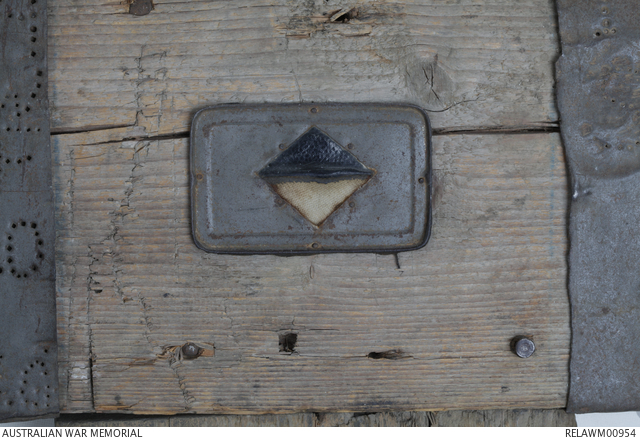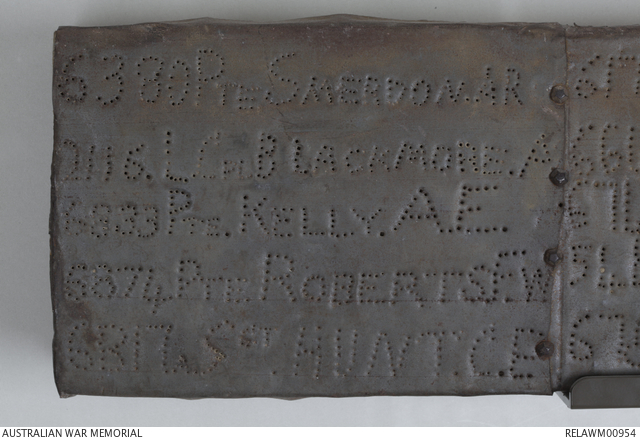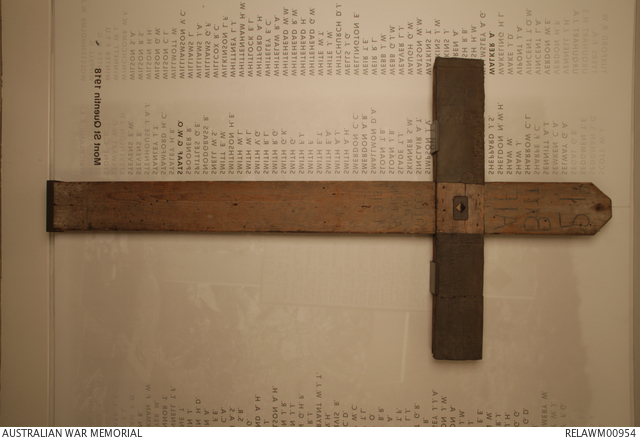| Place | Europe: France, Picardie, Somme, Mont St Quentin |
|---|---|
| Accession Number | RELAWM00954 |
| Collection type | Heraldry |
| Object type | Heraldry |
| Physical description | Tin, Wood; Brass |
| Location | Main Bld: First World War Gallery: Western Front 1918 |
| Maker |
Unknown |
| Place made | France: Picardie, Somme, Mont St Quentin |
| Date made | 1918 |
| Conflict |
First World War, 1914-1918 |
Mont St Quentin grave cross: 21st Battalion, AIF







Wooden grave cross. On the vertical arm of the cross is carved ’21ST BATT A.I.F’ and ‘KILLED IN ACTION 1918’. A small, rectangular, brass plate with the diamond colour patch insignia of 21 Battalion (black over red) has been attached to the centre horizontal. The red has faded to white. A rectangular piece of tin has been attached to both horizontal arms of the cross. The left piece of tin has been punched with the names of ten members of 21 Battalion who were killed on 1 September 1918 during the Battle of Mont St Quentin. The names are:
6380. PTE SMERDON. A.R
2116. L.CPL BLACKMORE. A
6833. PTE. KELLY. A.E
6874. PTE. ROBERTS F.W.
6817A SGT. HUNT. C.E
6178. PTE THORBURN. W.H
664. PTE. THOMPSON. E.W
6747. PTE. DOWELL. W.F
5413. PTE. STAFF. G.W.O (incorrectly spelt, correct spelling is Staaf)
6781. PTE. CHANDLER. D.G.G
The right hand piece of tin has been punched with '1 UNKNOWN'.
On 3 September 1918, 11 men from 21st Battalion, killed in the storming of Mont St Quentin, were buried by their comrades in a shell crater with this memorial cross erected over them. The cross was collected by the Australian War Records Section on 4 July 1919 and a new cross erected over the graves.
Such grave-markers were important to visitors who had lost loved ones, as they had little prospect of making the long trip to France to see the graves themselves. The cross was first put on display in the Exhibition Building, Melbourne when the “Australian War Museum” opened on Anzac Day 1922. Early editions of the Melbourne exhibition guidebook noted of the cross that “since it has been on view the majority of the parents of the fallen soldiers whose names appear on it have made special visits to the War Museum to see it”.
The capturing of Mont St Quentin was part of the Allied counter offensives in the late summer of 1918. Sometimes regarded as the finest achievement of the AIF, the Battle for Mont St Quentin began on the night of 31 August when the 2nd Australian Division crossed the Somme River and attacked Mont St Quentin at 5 am from the northwest. It was a difficult position as it was an uphill fight for the troops, across very open ground where they were vulnerable to attack from the German-held heights above.
By 7 am on 1 September the troops had gained the village of Mont St Quentin and the slope and summit of the hill, by working in small groups. The five German divisions dispersed, and the Allied troops had broken through lines to Péronne by 8.20 am.
However, the Germans quickly regrouped and launched a counter-attack, and the rest of the day saw fierce fighting and heavy losses. The outnumbered Australians were pushed back off the summit of Mont St Quentin. Relief battalions were sent, and with their reinforcement, all the areas were retaken by the Australians, but at the cost of 3,000 casualties.
British Commander General Lord Rawlinson remarked that he thought this feat by the Australian troops under Lieutenant General Sir John Monash's command was the greatest of the war.